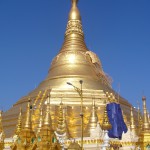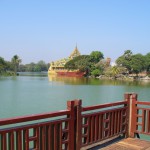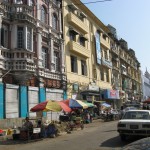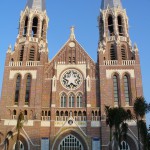We really didn’t know what to expect in Yangon and Myanmar. With the American embargo here, and little information, plus the insistence by our travel agent on booking us into deluxe hotels and pre-set meals, we had an impression of a backward country where one might not dare to tread by oneself. In other parts of SE Asia, however, we had heard very positive comments from other travelers who said things here were progressing rapidly. And then Secretary of State Hillary Clinton had just come to visit, and that was encouraging. Still, we were a bit uncertain about what we would find.
We can now report, with a day’s impressions, that we found this city of 6 million people much like other large ones in SE Asia. Perhaps in some respects it’s a decade behind the others, but it offers many wonderful things to the traveler.

There are the main sights, of course, which typically means the pagodas, or payas here. There is the big one, Shwedagon, dating from 2600 years ago, adorned with an enormous golden stupa from 600 years ago, and constantly renovated and enhanced with side chapels – a rival in size and scope to the royal palace temple in Bangkok.

There is another gold stupa in the center of town, the distance from which the British colonial overlords set the address system still used today. And then there is the largest Buddha statue we have seen, a reclining image 70 meters (225 feet) long.
And in town, there are dozens of major English-style buildings dating from the late 19th and early 20th century erected during the British occupation, buildings repurposed for other commercial or government use. Plus a host of minor buildings from that time.

That’s the beaten track here. But if you dare to tread outside this narrow track, you find surprising delights. On the northern edge of the central city is a large lake and park we visited, with a variety of things to enjoy. A simple, but inviting, botanical garden that includes organic vegetable growing for research, and next to which a dozen flower stalls offer gorgeous orchids and flowers. A separate area for children to play. Also, an area for evening and weekend entertainment, filled with many diverse casual restaurants and a supersized, ornate imitation of a royal barge for major parties. On our first night, as we heard from across the lake, this area featured a raucous beauty contest for Ms. DR, sponsored by DR cosmetics.

On the streets of downtown Yangon, you see a vibrant street life akin to other cities, but with much less crowding and noise. There are many high end restaurants downtown, plus the typical inviting local ones that spill onto the street. Unlike other cities in SE Asia, howover, the street stalls offer wide ranging cuisines, appealing to local, Chinese, Indian and Thai tastes. We even found two city supermarkets faster than we found them in Hanoi.

Quirky new buildings nestle in among the worn ones and the even older British ones, while larger construction projects appear on many blocks. Better yet, you can actually walk on the sidewalk, as long as you are careful to avoid the gaping holes in the patchwork paving that will drop you into the sewer if you’re not careful.

Unlike other major Asian cities, scooters and cycles are not allowed, therefore don’t park all over the sidewalks. Many of the cars are beaters, especially the taxis, yet newer and luxury cars are surprisingly common. Oddly, most feature a steering wheel on the right side, despite the switch to driving on the right in 1975. It is the job of the passengers to assist the driver in making a left turn.
Throughout the central city, religious institutions of diverse sorts mix amicably, and large donations clearly flow to sustain them.

The grand brick-red Catholic church, St. Mary’s, sits near a large mosque. Near the central Buddhist pagoda, a commodious Baptist church is open to all. There is in Buddhism, the principal religion here, a wide-open acceptance of all. The Shwedagon pagoda, one of their holiest religious sites, is currently lit in red and green at night for the Christmas, and New Year, holidays.
Even the night of our arrival, our first impression was a strong one: a fancy new airport terminal, and an uncrowded and efficient immigration queue, with officials happy to teach us a few words (Thank you = chezubay; Hello = mingalabar). Then, a drive into town along multi-laned, well paved roads, with many cars, but a much more disciplined traffic system. For example, cars entering a roundabout/rotary actually yielded to those already in the rotary.
Our deluxe hotel, though not our usual fare, was one of many ringing the lake, making an ensemble that would be the envy of any city. This hotel, we learned, was where Hillary Clinton stayed during her visit to the leaders here. To serve patrons like us, moreover, a host of fine restaurants nearby offered more high end dining at U.S. prices.
To be fair, however, Yangon may be about a decade behind other large cities here. ATMs are now appearing, but only within the last month or so. Street stalls offer push-button telephones for those who have no service, and you see few cell phones either, though a number of mobile phone stores. Electricity is an off and on thing, and generators are ubiquitous for businesses large and small. With less street lighting, however, there is a welcome dark that settles here, and you can actually see some stars.
Finally, we’re a curiosity to many residents here, since tourism has not quite hit fully, but not as much as you would think. We stopped to take a break for a beer at a very local bottle shop here, and a few people inside the shop came out to stare at us, plus the local crazy guy stopped to caution us about something, but otherwise we just became part of the scene, greeted by young children in smiles when a few passed by.
So we found Yangon very much like and in some ways unlike the other Asian cities on our trip. Getting outside the tourist track showed us how comfortable and accommodating the city could be. And perhaps our very normality in the streets helped those we met in Yangon grow a bit as well.
(For more pictures from Myanmar, CLICK HERE to view the slideshow at the end of the Myanmar itinerary page.)

